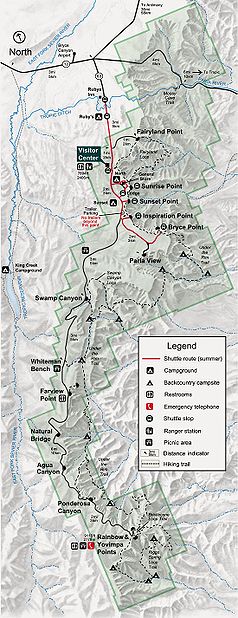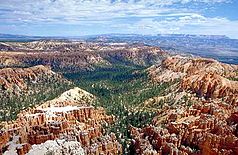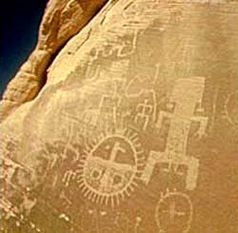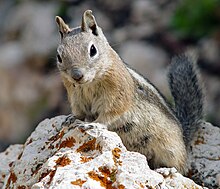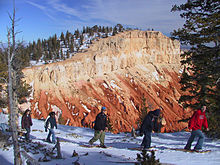Bryce Canyon National Park
| Bryce Canyon National Park | ||
|---|---|---|
| Erosion forms in Bryce Canyon | ||
|
|
||
| Location: | Utah , United States | |
| Next city: | Tropic (Utah) | |
| Surface: | 145.02 km² | |
| Founding: | September 15, 1928 | |
| Visitors: | 2,679,478 (2018) | |
| Address: |
Bryce Canyon National Park PO Box 170001 Bryce Canyon, UT 84717-0001 Tel. (435) 834-5322 |
|
| View from Bryce Point | ||
| View from Sunset Point | ||
| One of the most famous hoodoos in Bryce Canyon National Park: Thor's Hammer | ||
| Petroglyphs in the park | ||
The Bryce Canyon National Park is located in southwestern Utah in the United States .
The reason for the designation as a national park is the protection of the colored rock pyramids, the so-called hoodoos , on the edge of the Paunsaugunt plateau. This termination is predominantly non-linear. Instead, open, semicircular rock basins to the east have eroded into the plateau, which the national park administration describes as a “natural amphitheater ”. The largest of these is the amphitheater incorrectly as Canyon designated Bryce Canyon.
Bryce Canyon National Park is located at an altitude of 2400 to 2700 meters, which is much higher than the nearby Zion National Park and Grand Canyon National Park .
The park was settled by white settlers around 1850 and got its name from Ebenezer Bryce who settled there around 1875. The national park was declared a National Monument in 1924 and a National Park in 1928 . Today well over a million visitors visit the park annually.
geography
Bryce Canyon National Park is located in southwest Utah about 80 km from Zion National Park. The 300 meters higher location is associated with lower temperatures and more precipitation.
The national park is located on the Colorado Plateau , more precisely on the southeastern edge of the Paunsaugunt Plateau . The name Paunsaugunt is derived from the uto-Aztec language of the Paiute - Indians and means home of the beaver . Visitors reach the park from the plateau side and look over the edge into the Paria valley with the river of the same name. The word Paria also comes from Uto-Aztec and means elk or elk water .
Bryce Canyon was not formed by a river. It is therefore not a canyon in the true sense of the word like the Grand Canyon, for example. Wind, water and ice eroded the edge of the plateau into large amphitheatres with bizarre pinnacles, so-called hoodoos . These rock needles reach a height of up to 60 meters. The amphitheater created in this way extends over a length of over 30 km. The largest amphitheater is called Bryce Canyon. It is nearly 5 km wide, 19 km long and slopes over 240 meters from the plateau.
history
Early Indian settlements
Little is known about the early human settlement of this park. Archaeological finds date back 10,000 years. A few finds from the southern part of the area are attributed to the early Anasazi Indians in the basket-making era, some more recent finds to the Anasazi from the Pueblo era.
When the Anasazi Indians left the area for reasons that are still unknown, the Paiute Indians came, but there are hardly any traces of settlement to be seen. The Paiute used this area more as a hunting ground. However, remains of cultivated plants and agricultural use have also been found. The Paiute call the hoodoos Anka-ku-wass-a-wits , faces painted red.
Exploration and settlement by whites
The exploration of this area began as early as the 19th century. Around 1850, the first Mormons came to examine the area for arable farming and livestock farming.
The first scientific expedition reached the area in 1872 under the direction of US Major John Wesley Powells . The cartographers on this expedition took many names from the Paiute.
Just a year later, a small group of Mormons came and settled there to raise cattle along the Pariah River.
1875 Ebenezer Bryce from the Church of Jesus Christ of Latter-day Saints sent here to work on the development of the area as a carpenter. He built a road up to the plateau in order to cut trees there and to extract boards and firewood. He saw the natural wonder more from the practical side and described it as "a hell of a place to lose a cow" . His neighbors named the canyon near his cabin Bryce's Canyon . Together with other settlers, Ebenezer Bryce built a canal to cope with the constant flooding followed by dry spells. But the project failed, and so he moved on to Arizona in 1880 .
The creation of the park
The Powell reports and other newspaper reports sparked interest in the area, but tourism was limited due to a lack of infrastructure .
Around 1920 the first overnight accommodations were created and the Union Pacific Railroad opened up the area, so that more and more tourists came to Bryce Canyon. Unbridled tourism, however, quickly damaged hoodoos and other geological formations. The then governor of Utah supported efforts to protect the canyon and so the canyon was declared a National Monument by President Warren G. Harding in 1923 .
In 1924, the Utah Congress tried to establish the Utah National Park , which was successful in 1928. The name, however, stayed with Bryce Canyon National Park .
In 1931, under President Herbert Hoover, additional land south of the park was integrated into the park and its area increased to over 14,000 hectares . In 1934 construction began on the Scenic Drive , which still runs through the park today. The management of the park remained with the management of Zion National Park until 1956 . Since then the park has had its own administration.
Due to the increased tourism, a shuttle system was established in 2000. Efforts are being made to make large parts of the park only accessible via this shuttle system, as is already the case in Zion National Park.
geology
The rocks in Bryce Canyon National Park are about 100 million years younger than in Zion National Park , and this shows rocks that are another 100 million years younger than in the Grand Canyon . Nevertheless, all three areas belong to a formation called The Grand Staircase . From the Grand Canyon to Bryce Canyon, you can study nearly 200 million years of geological history.
The rocks in the national park are a sequence of basalt and sandstone , in which many fossils can be found. These exposed layers are the youngest in this formation. Sandy beaches, lagoons and a swampy landscape can still be seen today .
When the area rose in the course of mountain formation , numerous lakes were created, the sediments of which covered the basalt and sandstone. This lake district lasted about 20 million years and ended about 60 million years ago. During this time the lakes changed due to climatic changes, among other things. Due to strong variations in size and depth, they left behind strongly changing layers of sediment.
About 16 million years ago the plateau rose nearly 1,000 meters. Before that time, the area was almost at sea level. The entire plateau is called the Colorado Plateau. It broke into numerous smaller plateaus. One of them is the Paunsaugunt plateau.
As the American continent drifted further north, the climate on the plateau changed, it became significantly cooler and rainfall increased. Frequent rainfall and erosion from freezing water shaped the present day face of the numerous amphitheatres, which form an eastward stratification . Even today there are up to 200 periods of freezing and thawing weather per year, which are still eroding the park.
Flora and fauna
The park's forests and meadows are home to many birds and mammals. There are around 60 native mammal species and over 175 different bird species, many of which are not native to Bryce Canyon National Park all year round.
The predators range from foxes and other smaller animals to the occasional immigrant bobcat ( Lynx rufus ), mountain lions (Puma, Puma concolor ) and black bears ( Ursus americanus ). The largest permanent mammal in the park is the mule deer ( Odocoileus hermionus ). Wapitis ( Cervus elaphus ) and pronghorn ( Antilocapra americana ), which were reintroduced in neighboring areas, also occasionally appear as "visitors". A very common sight are the gold-coated ground squirrel ( Spermophilus lateralis ) and rock squirrels ( Spermophilus variegatus ) as well as the Uinta chipmunks ( Eutamius umbrinus ) and the Utah prairie dogs ( Cynomys parvidens ). The mule deer, the pumas and the coyotes migrate to lower regions in winter while the ground squirrels and marmots hibernate .
Most bird species in Bryce Canyon National Park migrate south in winter ( migratory birds ), such as the violet tern ( Tachycineta thalassina ) and swifts . However, some stay here all year round, including the jays (especially the pine jay ( Clark's Nutcracker, Nucifraga columbiana )) and the diademed jay (Steller's Jay, Cyanocitta stelleri ) and common ravens ( Corvus corax ), the osprey ( Pandion haliaetus ) and the peregrine falcon ( Falco peregrinus ) as well as various owls and nuthatches .
The herpetofauna consists of eleven reptiles and four amphibian species . Particularly noticeable among the snakes are the Great Basin prairie rattlesnake ( Crotalus viridis lutosus ) and the striped whip snake ( Masticophis taeniatus ), among the lizards the short-horned toad lizard ( Phrynosoma douglassi ) and the common iguana ( Uta stansburiana ). Among the amphibians, the tiger salamander ( Ambystoma tigrinum ) is one of the most interesting species.
Due to the different heights and the associated differences in vegetation within the park, different habitats are delimited:
- The lower areas of the park are characterized primarily by pine and conifer forests interspersed with Manzanita, June berries and bitter antelope bushes . Aspen , water birch and willow trees can be found along the rivers .
- Stocks of ponderosa pine ( Pinus ponderosa ) indicate the center positions, in wetter areas complemented by blue spruce and Douglas fir .
- Douglas fir predominates on the Paunsaugunt plateau, together with aspen and Engelmann spruces . The Nevada circular pine ( Pinus flexilis ) and the awning pine ( Pinus longaeva ) dominate the coldest and highest areas of the national park.
The park is characterized by a very dark and nutritious soil. Together with the abundance of water in the region, it ensures optimal living conditions.
activities
The 29 kilometer long Scenic Drive leads to a total of 13 viewpoints, including Sunrise Point , Sunset Point , Inspiration Point and of course Bryce Point . Further south of the park are Natural Bridge (geologically not a bridge, but an arch) as well as Rainbow Point and Yovimpa Point .
The park offers numerous hiking trails of different lengths and degrees of difficulty, for example:
- Rim Trail between Sunset and Sunrise Points (easy, less than 2 km)
- Mossy Cave (easy, less than 2 km)
- Upper Inspiration Point (medium, less than 2 km)
- Swamp Canyon Loop (medium, 7 km)
- Navajo Loop (medium, 3 km)
- Riggs Spring Loop (difficult, 14 km)
- Queen's Garden Trail
- Peek-a-boo Loop (difficult, can be combined with Queen's Garden Loop and a path of the Navajo Loop as an entry point, then approx. 12 km, 550 meters in altitude )
The air in Bryce Canyon National Park is so clear and the area is so dark at night due to a lack of infrastructure that you can see well over 7,500 stars in the sky with the naked eye. Up to 2000 stars are common in inhabited, light-polluted areas. Due to the clear air, views of up to 320 km to Arizona and even New Mexico are possible on nice days .
See also
literature
- John M. Fahey Jr., Gilbert M. Grosvenor, Nina D. Hoffmann, Kevin Mulroy: National Geographic Guide to the National Parks of the United States. National Geographic Society, Washington DC 4 2003, ISBN 0-7922-6972-1 .
- Ann G. Harris, Esther Tuttle, Sherwood D. Tuttle: Geology of National Parks. Kendall-Hunt, Dubuque 5 1997, ISBN 0-7872-5353-7 .
- Secrets in The Grand Canyon, Zion and Bryce Canyon National Parks. National Photographic Collections. Lorraine Salem Tufts, North Palm Beach Fl 3 1998, ISBN 0-9620255-3-4 .
- National Park Service: The Hoodoo . Fall, Winter, Spring edition 2003-2004.
- National Park Service: Bryce Canyon visitors guide. (some public domain text in the biology section)
- United States of America: Bryce Canyon National Park, Utah. A guide. Washington 1947.
- Frank De Courten: Shadows of Time, the Geology of Bryce Canyon National Park. Bryce Canyon Natural History Association, Utah 1994, ISBN 1-882054-05-9 .
- Eugene P. Kiver, David V. Harris: Geology of US Parklands . John Wiley & Sons, New York 5 1999, ISBN 0-471-33218-6 .
- Douglas A. Sprinkel, Thomas C. Chidsey Jr., Paul B. Anderson: Geology of Utah's Parks and Monuments . Utah Geological Association. Publishers Press., Salt Lake City Utah 2000, ISBN 0-9702571-0-4 .
- Robert C. Lindquist: The geology of Bryce Canyon National Park . Bryce Canyon Natural History Association, Utah 1977.
Web links
- National Park Service: Bryce Canyon National Park (official site; English)
- Information about the national park in German
- Mineral Atlas - Bryce Canyon (with information on the geological history of the canyon)
- Spherical panoramas - Bryce Canyon


